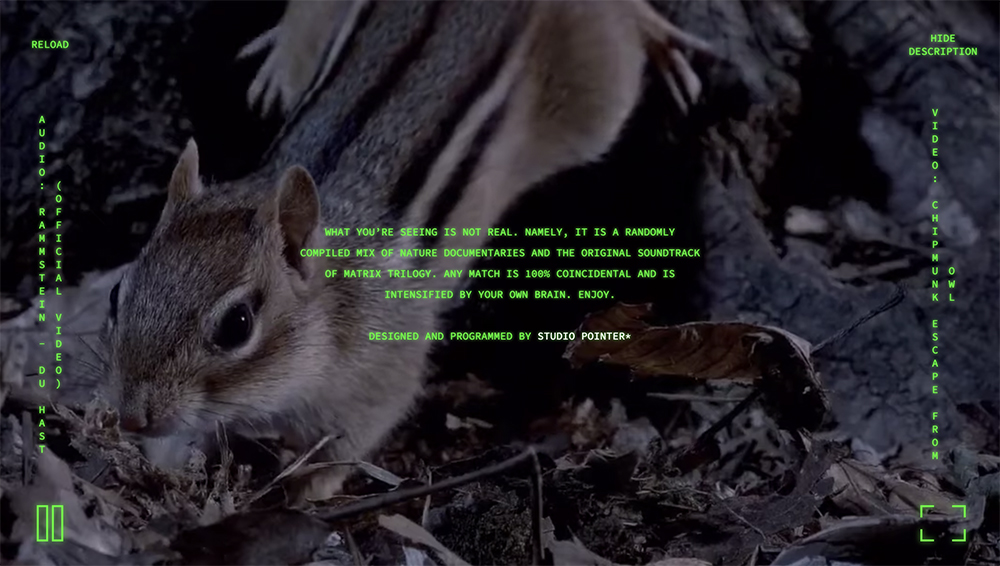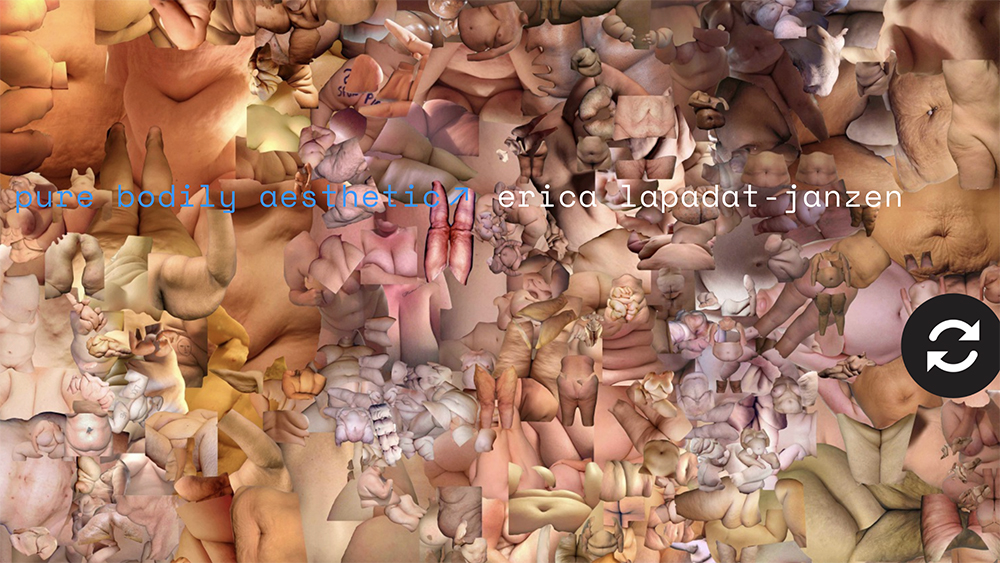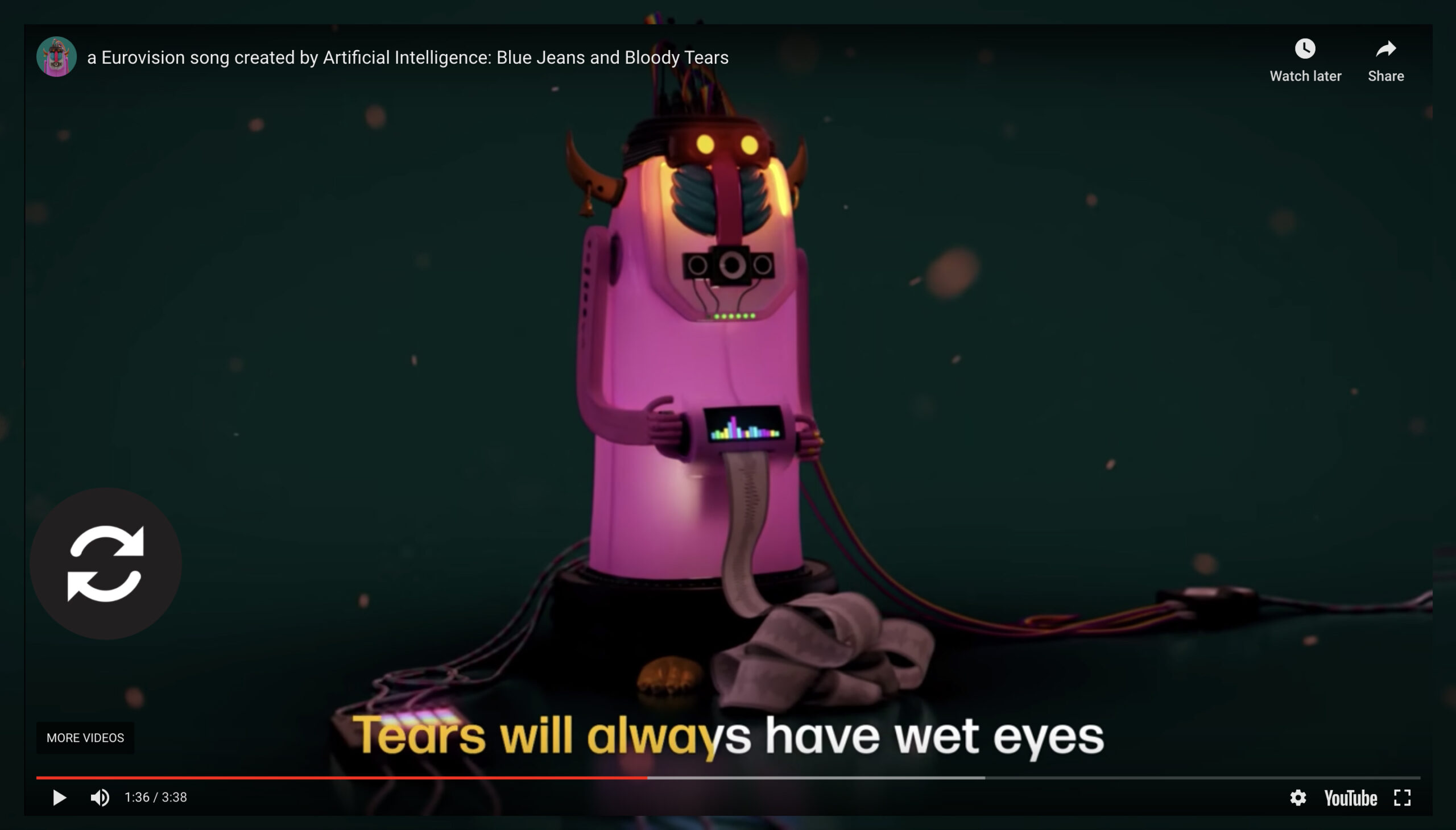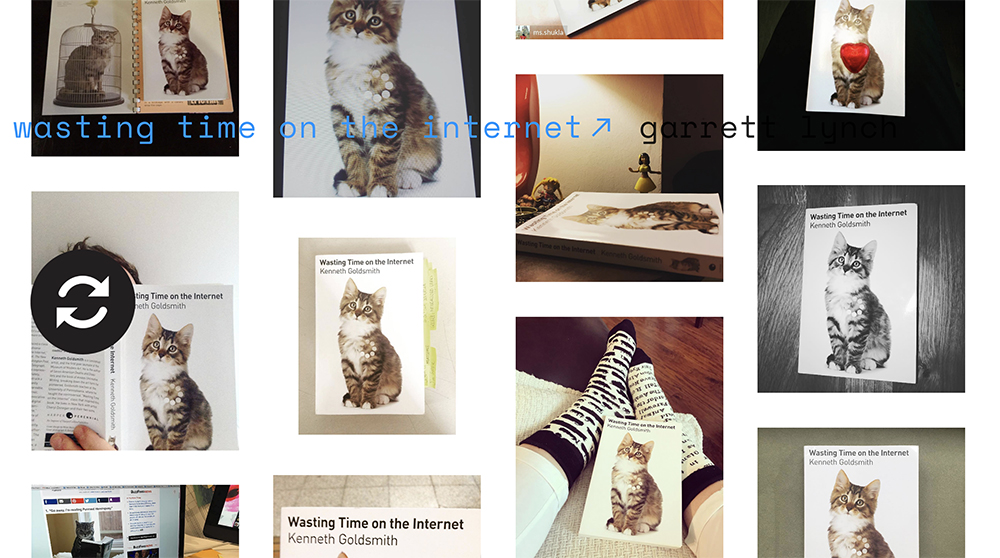By Lara Chapman
9 April, 2020
➪ I press refresh
A video starts buffering on my screen. A blurry beige shape comes into focus, revealing the upper thighs of a woman. She is wearing a pair of saggy nude coloured underpants. At the top of her legs, a pair of superimposed eyebrows rise and fall, rise and fall. I chuckle. It’s suggestive, creepy and absurd all at once—a sort of surrealist animated internet collage.
^^ Rachelle Beaudoin, ‘Thighbrows’, (2016)
I am ‘visiting’ the exhibition Press Refresh. Showcasing the work of over one hundred and five artists, this group show is unlike any other I’ve ‘been’ to before. To get to the exhibition, I make myself a cup of tea, wiggle into the corner of my couch, open my laptop and start to type p-r-e-s-s-r-e-f-r into Google’s search bar. At this point, Google completes my search, suggesting: www.press-refresh.net. I use my arrow key to scroll down and hit enter, and just like that, I am ‘in’ the exhibition.
➪ I press refresh
A GIF of five thin black lines grow in parallel down the webpage. The lines expand in three stages—short, mid-length, long—before the GIF loop begins again. Short, mid-length, long. What is this about? I click a hyperlink that reads ‘nails.glitch.me’, and I’m directed to a blank webpage. My cursor transforms into the back of a chubby little hand wearing a Mickey Mouse-esque white glove. When I click my mouse, the hand makes a fist, and, as I drag the cursor downwards, five parallel lines appear. I can digitally scratch sideways and downwards, but not upwards. Like running a nail down a blackboard, it feels exciting, but slightly unpleasant, a bit disobedient. Its tactility seems to straddle an online/offline divide.
^^ Char Stiles, ‘Nails.Glitch.Me.’, (2019)
Press Refresh is curated by David Quiles Guilló, who describes himself as ‘an art project maker, new media powerhouse, awarded creative and full weirdo at large.’ According to Press Refresh’s website, the exhibition is ‘an ongoing group show, open to submission, showcasing one by one, a selection of digital culture artefacts.’ I would describe it more as net art roulette. To navigate the exhibition, you use a chunky black and white refresh button that floats on the page. Each time you press it, a new work appears on your screen. The works are varied in their media formats and include videos, JPEGs, slideshows, animations and screenshots.
➪ I press refresh
A shaggy millennial pink carpet floats in the middle of my screen, Aladdin style. It ripples and twirls in a slow dance, while its fluffy hair bristles, then flattens, then bristles, then flattens over and over in different patterns and configurations. Its oddly soothing effect evokes an ASMR (autonomous sensory meridian response).1 Is the work commenting on this intriguing and hugely popular phenomenon of the internet? Celebrating it? Experimenting with it?
^^ Aimee Suggitt, ‘Carpet’, (2019)
The randomised style of navigation, alongside the lack of overarching curatorial framing other than ‘internet friendly’ and ‘belonging to any digital art modality and beyond’, results in a certain amount of discombobulation for the viewer. It’s disorienting, both in the context of the internet, and the context of an exhibition. I’m accustomed to image-heavy web pages that are designed to make navigating their links easy, frictionless; websites that encourage me to stay there a little longer and click another hyperlink. I’m used to exhibitions holding my hand, guiding me through the works on display and the artists that made them, offering carefully edited and digestible captions that direct my understanding and interpretation.
Press Refresh offers no descriptions of the works on display, nor any context from which to start interpreting them. With these elements stripped away, the exhibition seems almost apathetic to the viewer. ‘Take it or leave it’, the website whispers to me. If you’re bored, click refresh or go somewhere else, whatever.
This aloofness, and the lack of instruction, has its roots in the early days of net art which, in the early-mid 1990s, was often made for other net artists and used its own subversive vernacular.2 Press Refresh’s broad curatorial framing also reflects the slipperiness of ‘net art’—we’ve been debating what it actually is for the past three decades. Andreas Brøgger explains that net art’s definitions can range from the strictest (‘net art is art that cannot be experienced in any other medium or in any other way than by means of the network’) to the very loose (‘net art is art that deals with ‘the net’ and all that the net is about (chat, economics, distribution technology, copyrights, browsers, cookies, big-time corporate mergers, etc.), regardless of medium.’)3

Studio Pointer, Nature Documentaries and Matrix Soundtrack, (2019)
as exhibited as part of Press Refresh
image courtesy the artist and Press Refresh
➪ I press refresh
A giant red ant peers out of my screen. The ant is surrounded by what appear to be stones, but I think they are extremely close-up grains of sand. Neon green text glows around it. I click on a hyperlink and I’m transported to a black screen with a single green glowing word: ‘Enter.’ I click it. The text glitches, and heavy metal music blares out to a video of a dung beetle rolling a dung-ball around. ‘What a hard core dung beetle,’ I think. I press the ‘reload’ button, and the video changes to a mob of meerkats peering into the distance. The music is replaced by a heroic symphony. I ‘reload’ again, and this time a sloth paddles through clear blue water, while sinister orchestral strings staccato in the background. For this work, Studio Pointer has constructed a video interface that randomly generates pairings of nature documentary clips and the Matrix soundtracks. The description reads: ‘Any match is 100% coincidental and is intensified by your own brain.’ It’s a strange concept, and the results are bemusing and surreal. It feels like a new age collage that applies new technologies and programming to the traditional technique of cutting-and-pasting images together. In its odd hilarity, the website also offers an insight into how easily our perceptions and emotions can be shaped, triggered, and manipulated, by video editing.
^^ Studio Pointer, ‘Nature Documentaries and Matrix Soundtrack’, (2019)
Despite its aloofness, or perhaps because of it, Press Refresh gives agency to its audience. All control is placed at each visitor’s fingertips. If something captures your interest, you can click the hyperlinks, Google the artist, see their other works. A large portion of what is on display are videos. In a gallery setting, I’m often frustrated by not knowing where a video work is up to, how long it will last, or I’m just unable to navigate through the video in question. For Press Refresh, the videos are situated in their natural habitat of the World Wide Web. I can happily skip forwards, backwards, change the volume, see the video progress bar, and choose to watch a little or a lot. Some videos I spent a long time with, others merely seconds. Some made me reel back from my screen, the noise and visuals overwhelming me. Others soothed me. Many of the videos made me lol. There were lots I didn’t exactly understand. Some were incongruously honest and raw.
The experience of watching videos via Press Refresh is quite different than watching them on other online platforms, such as YouTube or Facebook. Usually, videos are fed to me via a ‘curated’ string of codes that have access to my browsing history, cookies, likes and dislikes, and viewing habits. The algorithm is eager to please, hoping to entice me to watch the next video, and thereby watch the next targeted advertisement. In contrast, Quiles Guilló’s selection of videos certainly does not cater to me. If they cater to anyone, it’s probably Quiles Guilló himself, reflecting his own ‘weirdo-at-large’ interests and subjectivities.
My extreme responses to the videos in Press Refresh—from soothed to repulsed—highlights how frictionless my normal browsing experience is. It shows me just how effective the curatorial algorithms are at guiding me on a shiny path of recommendations.
➪ I press refresh
Another video begins buffering. Red and white LEDs flash at each other, as if in conversation. An eery omniscient voice starts narrating. ‘Once I was everywhere and now I was somewhere.’ Slowly, a gloss-tastic human figure becomes the main focus of the film. I watch this ‘person’ moving through desolate cityscapes. Empty and abandoned. Everything is computer-rendered: the quiet streets, the unoccupied buildings, the unexamined sculptures. I watch the whole 14 minutes and 22 seconds of the video and then begin it again, feeling I’ve missed something, but I still don’t know what that something was. It’s unsettling, and beautiful.
^^ Ryan Cherewaty, ‘Memory of Death’s Dream’, (2018)
Many of the works in the exhibition are self-referential, dealing with topics relating to various aspects of internet culture, online spaces, digital tools, or our relationship to our devices. Some of the works explore the digital world playfully—Damjanski’s ‘Humans Not Invited’ (2018) invites you to take a test in which you have to identify certain objects in blurry coloured pictures. Should you fail the test, the message ‘YOU’RE ARE HUMAN. YOU ARE NOT INVITED’ appears on the screen. Other projects deal with the digital more abstractly—Hugo Livet’s ‘Dérive’ (2019) is a slideshow of photographs of icebergs that are perfectly smooth and geometric. They look almost architectural, and there is an ambiguity about the photographs’ truthfulness—are they real or rendered? For me, ‘Dérive’ reflects our ability to manipulate images, and create more perfect, more sculpted, more flawless versions of ourselves online.

Erica Lapadat-Janzen, Pure Bodily Aesthetic, (2017)
as exhibited as part of Press Refresh
image courtesy the artist and Press Refresh
At times, the fact that the artworks are deeply embedded in different aspects of internet culture can be somewhat alienating. The viewer needs a certain amount of prior knowledge to truly appreciate the nuances, references, complexities and specific vernacular of these artworks. There is a threshold for understanding.
To tackle this void, it’s possible to simultaneously browse while ‘in’ the exhibition, seeking answers in the online spaces that the work is referencing. However, you have to know there is something to look for in the first place. For example, initially, I found ‘Thighbrows’ simply amusing. But, on a whim of curiosity, I googled the term and discovered that #thighbrow is a body trend that started in 2015. The hashtag and term describe ‘the line on the top of your thigh that appears when you sit, kneel, or bend forward and the flesh from your booty rolls on top of your thigh.’4 With this knowledge, the humour of the piece becomes satirical, mocking the absurdity of body trends born in the image-sharing spaces of Instagram and the internet-at-large.
I suspect there were many references and layers I completely missed. That said, the majority of the works are engaging without any knowledge of their hidden meanings. On the occasion when you do understand something further, it feels like the work is giving you a little emoji wink and a thumbs up.

Sweaty Machines, Blue Jeans and Bloody Tears, (2019)
as exhibited as part of Press Refresh
image courtesy the artist and Press Refresh
➪ I press refresh
Towards the end of my clicking frenzy, I encounter a pink robot with funky shoulder dance moves who is belting out the world’s first Eurovision song composed by AI. I find myself singing along karaoke-style to the upbeat-electro-poppy tune entitled ‘Blue Jeans and Bloody Tears’ for a full 3 minutes and 22 seconds. The song was created by feeding past Eurovision melodies and lyrics into a deep learning algorithm, allowing it to create its own song based on the identified patterns. Despite the absurdity of applying AI to Eurovision, the project points to the creative potential of collaborating with AI. It suggests the forms of profound nonsense that occur when computers are not constrained by what is appropriate or expected. The artwork epitomises what Sianne Ngai calls the ‘stuplime’—a fusion of the stupid and the sublime.
^^ Sweaty Machines, ‘Blue Jeans and Bloody Tears‘, (2019)
There’s a strangeness that runs through all the works in Press Refresh, but there’s also a tingling feeling that something lurks beyond this nonsensicality. That is, Press Refresh exemplifies the ‘Weird Web’, a term coined by coder and net artist Neal Agarwal. Agarwal is referring to an early form of the internet that existed before the dominance of social media and the monetisation of clicks. He describes this web as: ‘a place where online creators expressed themselves through interactive content, games and experiments. It was a place that brought delight and joy.’ Press Refresh is a utopian internet kind of place. It reclaims an ad-free, creativity-fuelled version of our online experience.
In Wasting Time on the Internet (2016), Kenneth Goldsmith urges us to strive towards ‘re-enriching, re-enlivening, recuperating, and reclaiming the time we spend in front of screens—time that is almost always being dismissed as wasted.’5 I spent nearly four hours ‘at’ Press Refresh. The result was a very numb bum; a cold, forgotten, cup of tea; jittery eyeballs; hundreds of tabs open at the top of my window, and a lagging internet connection.
Press Refresh left me exhausted by its randomness, and overstimulated by its addictive mechanism, but I still left feeling intrigued. It invites you to dip your toes into a gloriously scatty sea of zeroes and ones as you float along its surface. There’s no need to navigate—you can let the digital tide take you where it will simply by click, click, clicking that big round refresh button.
Author’s post-script:
A little over a month ago (on February 27th to be exact), I emailed the editors of Running Dog, pitching the idea of reviewing Press Refresh. The reasons I decided to suggest this online exhibition were two-fold. Firstly, over the past year-or-so, I have become increasingly curious about the wild world of net art and how it is curated and disseminated. Reviewing Press Refresh allowed me to explore a small segment of this world in more depth.
Secondly, it was a tactical manoeuvre that allowed me to leap over a frustratingly practical hurdle. The hurdle came in the form of this polite sentence on Running Dog’s submission guidelines: ‘Please note that Running Dog is currently interested in reviews and feature articles on exhibitions or events taking place in Sydney and regional New South Wales.’
I’m from Sydney originally, but I live in London, yet I still wanted to write for Running Dog… f***. You can probably picture the train of thought that led me to its logical conclusion. Namely, that an online exhibition is also a NSW-based exhibition. An internet-based exhibition can be seen by anyone, anywhere, anytime without even leaving the house.
As you can imagine, four weeks ago, I was feeling pretty smug that I had managed to overcome a 8,500 km hurdle and review something I was also fascinated by. Four weeks ago, museums were still open. Four weeks ago, exhibitions were still attracting thousands of visitors. Four weeks ago, people were still travelling to foreign cities to cross another famous artwork off their Lonely Planet bucket lists.
Then, country by country, museums and galleries closed their doors indefinitely. Lockdowns began.
Very quickly, we’ve found ourselves unable to travel to where the art is.

Garrett Lynch, Wasting Time on the Internet, (2018)
as exhibited as part of Press Refresh
image courtesy the artist and Press Refresh
As a result, online galleries and digital museums have been popping up like pop-up ads. Many of the ‘digital exhibitions’ I have come across are simply web pages filled with photographs of physical objects. Others have tried to replicate the white-cube gallery experience through virtual tours or 3D rendered white-cubes filled with reproductions. Mostly, the online exhibitions are responding to the need to reach existing audiences by getting the offline, online (ASAP).
Jemma Kahn, a writer and producer, bluntly summarises the situation: ‘There’s been this explosion of mediocre rubbish coming out online.’ She goes on to explain that, as a producer, ‘it would break my heart to put any kind of theatrical experience online because that’s not what it’s made for.’ Although Kahn deals with performance and theatre, her words ring true for the many physical exhibitions that have suddenly shapeshifted. That’s not what it’s made for. For the most part, the shapeshifting feels like an exercise in PR under the guise of solidarity.
But what about the exhibitions that have lived and breathed online for some time? What about the natural inhabitants of the online space, a space that is now being colonised—or at least rapidly co-inhabited—by physical newcomers? What does art + the internet look like when it’s not spurned by a pandemic?
This is a moment to appreciate and learn from the digital makers who belong and thrive online. This is a moment to reflect on net art and the weirdness of the web. Reviewing Press Refresh showed me how an exhibition can be unashamedly odd and fun and strange. What is the value of this at such a time? What can online exhibitions do that physical ones can’t? What are their constraints and possibilities?
Eric Thurm poses the question: ‘If we are going to ‘be’ online, how should we do it?’
You would think he wrote this question in response to the last couple of months, pondering the conditions of lockdown, but he was asking this in 2018. Despite his focus on memes, the question is one I have been grappling with while writing this article. However, if I were to pose this question I would remove some of the words: If we are going online, should we do it? And if we should do it, then I’d replace the ‘should’ with a ‘can’: If we are going to ‘be’ online, how can we do it?
Press Refresh is one of an infinite number of possibilities of curating and creating online. There are millions of other ways that step out of the mundanity of replicating an offline exhibition digitally. I think the weird web and all its history can push us to imagine other ways of doing on the internet, giving us a space in which to question our underlying motivations for doing on the internet at all.
- German Lopez describes ASMR as ‘the term for the sensation people get when they watch stimulating videos or take part in other activities—usually ones that involve personal attention. Many people describe the feeling as “tingles” that run through the back of someone’s head and spine. Others say the feeling is deeply relaxing, and can even cause them to fall asleep.’
- Dylan Kerr, ‘The Early Disruptors: 7 Masterpieces of ‘90s Net Art Everyone Should Know About’, Artspace, (27/05/15)
- Andreas Brøgger, ‘net art, web art, online art, net.art’, Afsnitp.dk, (2000), n.p.
- Elizabeth Denton, ‘Are Thighbrows the New Thigh Gaps?’, Seventeen, (16/08/15)
- Kenneth Goldsmith, Wasting Time on the Internet, (New York: Harper Collins, 2016), p. 21. Fittingly, Press Refresh includes a kind of ode to Kenneth Goldsmith’s Wasting Time on the Internet in the form of a tumbler page made up entirely of images of the book in various spaces, the buffering cat on the cover peering out from the square photographs. In some ways, it is pointless and ironic but it is also a poetic illustration of Goldsmith’s thesis that maybe there doesn’t need to always be a point to what we do online, maybe we should be more playful and exploratory.